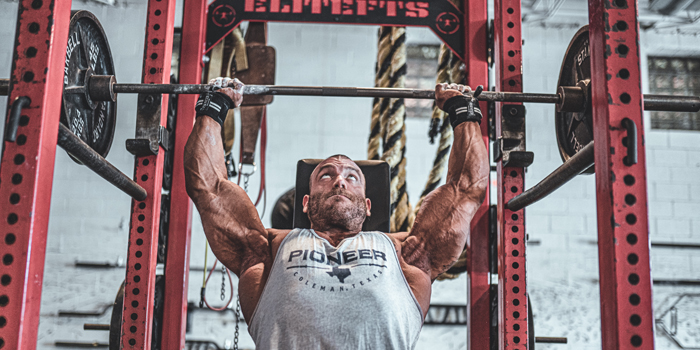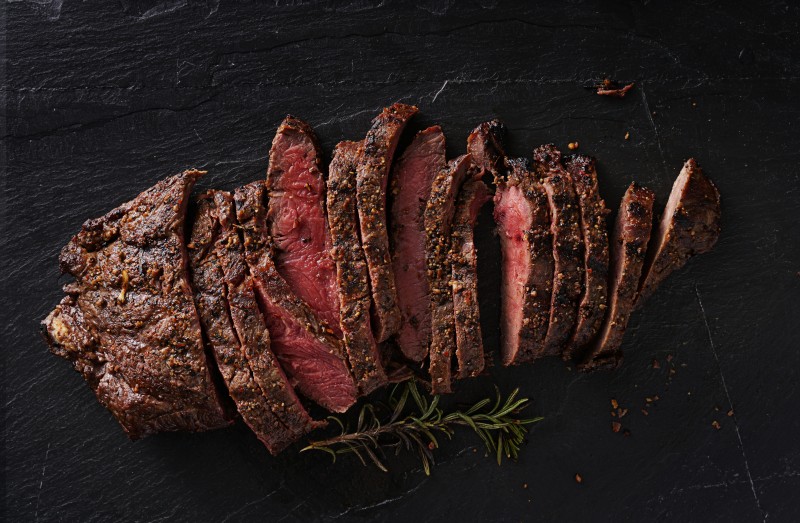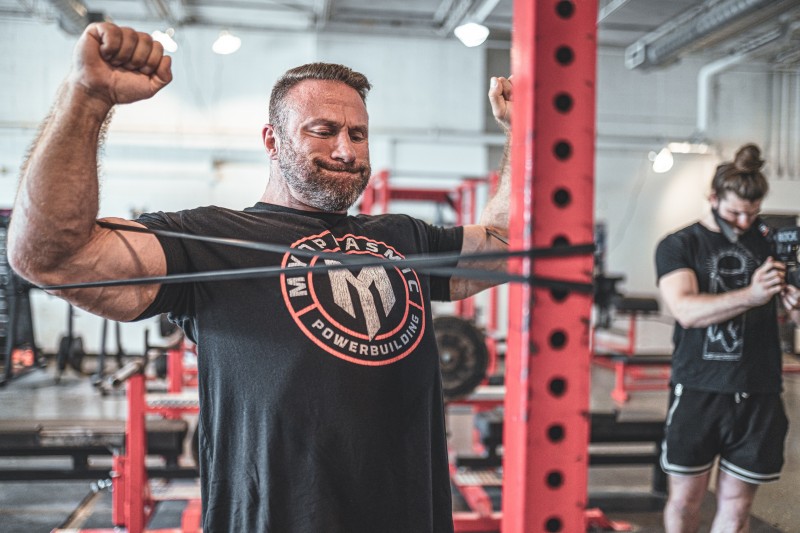
Building muscle as you lose fat is the holy grail of developing an amazing physique. This is often called the “lean gains” approach. Is it possible, and if so, under what circumstances? These are the questions that will be answered throughout this article. But first, we need to discuss how muscle growth occurs so that we can evaluate the efficacy of this approach for body recomposition.
Energy Balance and Muscle Growth
Energy balance is a term used to describe the relationship between energy input (i.e., food and drink) and energy output (i.e., metabolism, physical activity, etc.) (1). Also known as the first law of thermodynamics (2), it states that to gain weight, you must be in a caloric surplus, and to lose weight, you must be in a caloric deficit (1). This is true unequivocally and under all circumstances. However, energy balance is just one aspect of a complex subset of factors that influence the composition of an individual at a given bodyweight.
Hypertrophy occurs when the rate of muscle protein synthesis (MPS) exceeds the rate of muscle protein breakdown (MPB) (3). Contrary to how it may sound, muscle protein breakdown is not bad. In fact, it is actually quite important for tissue remodeling. Mechanical tension is considered to be the primary mechanism of hypertrophy, and resistance training has been shown to increase MPB (3). However, the rate of protein breakdown is exceeded by the significant increase in MPS following a bout of resistance training.
Additionally, hyperaminoacidemia (having excess amino acids in the bloodstream) and hyperinsulinemia (having excess insulin relative to glucose levels in the bloodstream) both down-regulate the MPB response post exercise. Therefore, meal timing and composition (specifically protein and carbohydrates) are important variables in optimizing hypertrophic signaling.
RECENT: The Ultimate Guide to Designing a Muscle-Building Diet
A paper by Iraki and colleagues found that “sufficient protein (1.6–2.2 g/kg/day) should be consumed with optimal amounts 0.40–0.55 g/kg per meal and distributed evenly throughout the day (3–6 meals) including within 1–2 hours pre- and post-training” (4). Based on these recommendations, a 100Kg individual should consume 160-220g of protein per day with each meal containing 40-55g of protein. However, another study found that increasing protein feedings to 70g increased “whole body anabolic response linearly with increasing amount of dietary protein without showing a sign of plateau, largely through a greater suppression of protein breakdown” (5).

Joshua Resnick © 123rf.com
I tend to agree with the 40-55g recommendations; however, I also see value in a higher per-meal protein intake amount if the athlete is substantially larger and more muscular. Using myself as an example, I’m somewhat skeptical that a 40g serving will optimize muscle growth for both a 170-pound lifter and myself weighing 285 pounds. However, this position is simply my personal opinion.
Now that we’ve established the relative importance of protein in the formation of new muscle mass, we can return to energy balance. The truth is, our bodies do not function as a closed system. For instance, one pound of fat is roughly 3,500kcal. If our metabolism were, in fact, 100 percent efficient, we could determine the exact caloric deficit to elicit one pound of fat loss by the end of the week. For example, 3,500kcal ÷ 7 days in a week = 500kcal daily deficit.
However, experienced dieters will attest to the fact that these calculations do not always have a linear relationship with the rate of fat loss. Our metabolism has adaptive processes that mitigate large fluctuations in bodyweight, likely as an evolutionary mechanism for survival (6). Relative to bodyweight alteration, this means that your maintenance energy intake is not simply a fixed number and is somewhat nebulous. This lack of precision creates a very significant obstacle to the lean gains approach, which essentially states that you can maintain your bodyweight while altering your body composition.
Calorie partitioning is a term used to describe how your body delegates incoming energy and nutrients. This process has several influences, including diet composition, energy balance, sex, adiposity, and genetic factors (7). The respiratory quotient value indicates which macronutrients are metabolized, as different energy pathways are used for fats, carbohydrates, and proteins (7). Genes that correlate with the respiratory quotient alter macronutrient partitioning, giving preference to carbohydrate oxidation and/or impairing lipid oxidation (7).
Essentially, the efficiency by which we can shuttle energy and nutrients for the purpose of synthesizing skeletal muscle will have inter-individual variability. Thus, if we take two individuals with similar anthropometrics, we may still observe variability in their oxidation and partitioning profiles. Several studies have conclusively demonstrated that we can decrease body fat while simultaneously increasing muscle mass (8)(9)(10). However, the primary concern with regard to recomposition is the magnitude of change that can realistically occur. One study mentioned that the gains in lean body mass (LBM) by the end of the trial were 1.2 ± 1.0 kg, and this outcome will by no means scale linearly. It’s also important to note that increases in LBM are not exclusively muscle; rather, they are actually a combination of muscle, water, glycogen, etc.
According to the National Health Statistics Report, the average body mass index (BMI) of males 20 years and older in the United States is 29.1 (11). To put that into perspective, a BMI of 30 or more is clinically defined as class 1 obesity by the United States Centers for Disease Control (12). I fully acknowledge that the average person reading this article likely does not fall into the obese category. However, my point is simply that most people who want to improve their body compositions are looking to lose more than just a few pounds of body fat and gain a few pounds of muscle. Thus, to accomplish a more dramatic change in your body composition, you would need to create an energy deficit.
Endocrine Response to Resistance Training in an Energy-Restricted State
Your endocrine system has a profound effect on nutrient partitioning and is largely influenced by energy balance and resistance training. The metabolic response to sustained caloric restriction can impact your thyroid, ghrelin, testosterone, sex hormones, growth hormone, resting energy expenditure, and more (13). This down-regulation of anabolic hormones, such as testosterone, creates an environment primarily focused on preservation rather than muscle anabolism (13). The thyroid is also known to play a role in regulating energy expenditure through brown adipose tissue and the cardiovascular system (14).
During true energy restriction, your body enters a chronic catabolic state, initiating tissue breakdown for energy utilization. For substantial hypertrophy to occur, you must be in a caloric surplus to elicit the anabolic signaling required for muscle growth. A catabolic state dampens anabolic signaling to metabolic machinery that is responsible for muscle growth.
So, although hypertrophy is possible during energy restriction, the amount is small, and the instances by which it occurs in more meaningful quantities are primarily limited to novice lifters, performance-enhancing drug users, and a handful of outliers. Researchers have also observed that intermediate and advanced athletes have decreased hormonal values (total testosterone, free testosterone, dehydroepiandrosterone, cortisol, and sex hormone–binding globulin) when tested post resistance training (15). This demonstrates an attenuated endocrine response as an athlete becomes more experienced. This is unsurprising because we know that as an athlete’s training age increases, their volume must also increase to stimulate continued muscle growth.

Image credit: Kyle Wurzel Creative
The amount of muscle growth that can occur in a caloric deficit is constrained by the law of conservation of energy. If there is a shortage of energy, tissue will be broken down and oxidized for fuel. Because muscle is a very metabolically active tissue, the energy cost is high. Therefore, the likelihood of experiencing muscle loss when one is in a caloric deficit is significant. Luckily, virtually all of this can be mediated through proper resistance training and a high protein nutritional protocol (8). However, in the event that you have covered all of your bases and made it highly unlikely to lose muscle, the energy required to fuel your daily activities does not disappear. Fat, glycogen, and other substrates will be oxidized for energy, but they are unlikely to be synthesized as muscle.
Research on muscle loss during energy restriction has demonstrated quite convincingly that reductions in MPS are largely responsible (16)(17). Pasiakos et al. reported a 19 percent reduction in postabsorptive mixed MPS when patients were subjected to a 20 percent energy-restricted diet for 10 days (17). The same paper found an 18 percent reduction in plasma insulin resulting from the energy-restricted diet (17). The down-regulation of insulin secretion and alterations in protein kinase C, nitric oxide, activated protein kinase (AMPK), and other factors help to mobilize glucose and free fatty acids to maintain plasma glucose concentrations and provide fuel to sustain exercise (18). Therefore, acute reductions in insulin during resistance training are not necessarily problematic. However, in the presence of sustained energy restriction, this will dampen anabolic signaling for muscle growth.
AMPK helps to regulate cellular metabolism (19). When energy availability is low, AMPK activation blunts several anabolic signaling pathways, including MPS, to preserve ATP (17). AMPK down-regulates mammalian target of rapamycin (mTOR, a signaling pathway associated with anabolism) by phosphorylating both Raptor and TSC2, thus inhibiting S6K1 (20). The mTORC1-S6K1 axis controls several cellular processes, including the transcription and translation of protein and cellular metabolism. Therefore, the activation of the AMPK pathway during a caloric deficit directly inhibits anabolic signaling for muscle growth.
In response to resistance training, cortisol concentrations increase. In this respect, cortisol plays several important roles, including the breakdown of tissue at injury sites to form amino acids (21). This can be problematic because a primary source of proteins is the skeletal muscle. Cortisol also blunts glucose uptake by tissues, down-regulates glycogen synthesis, and liberates free fatty acids (FFA) (21). Lipolysis is initiated in adipose tissue, which results in the release of glycerol and FFA to be oxidized as a usable energy source (21). However, strenuous exercise preferences carbohydrate oxidation, and the rate of FFA oxidation is outpaced by the energy demands of traditional bodybuilding training.
The fact that FFA liberation occurs in an energy-restricted state means that available energy will not be preferentially directed toward MPS. This energy will be oxidized to maintain performance, and because energy availability is insufficient for promoting muscle growth, it’s unlikely that any will occur.
Beyond that, the plasma hormone concentration and number of active receptors dictate how the tissues respond when exposed to a given hormone. And because energy restriction down-regulates the anabolic hormone concentration, it would simultaneously have a negative impact on the hormone’s ability to bind to receptors.
Insulin-like growth factor (IGF-1) is a hormone that plays a critical role in anabolic signaling (22). Resistance training stimulates the production and circulating availability of IGF-1, as it is highly responsive to mechanical loading. IGF-1 increases the rate of MPS, and as one paper found, it “increased intracellular Ca2+ concentration. This leads to the activation of multiple anabolic Ca2+ dependent pathways, including calcineurin and its numerous downstream signaling targets” (21). However, a 2009 paper discovered “our data suggest that chronic protein intake is more powerful than calorie intake in modulating circulating IGF-1 concentration in humans” (23). This falls in line with the bulk of the evidence suggesting that so long as sufficient protein intake and resistance training are maintained, muscle loss during energy restriction can largely be mitigated.
Differences Between Novice and Advanced Lifters
There are stark differences between novice and advanced lifters. It’s well established that even loads as light as 45-50 percent of 1RM are sufficient for producing substantial gains in hypertrophy and strength (24). However, a paper by Helms et al. recommends that the majority of training for intermediate and advanced lifters should occur between 70-80 percent 1RM (25). These differences are due to the limited exposure that novice athletes have with resistance training. Novice lifters also require substantially less volume to elicit muscle growth compared with their more experienced counterparts (24).

Image credit: Kyle Wurzel Creative
So, as you reach higher levels of muscularity, it becomes harder and harder to elicit further progress. Many seasoned bodybuilders are required to push their energy intake well beyond their maintenance to elicit the magnitude of the anabolic signaling required to synthesize new muscle. This is a well-documented (albeit anecdotal) phenomenon among bodybuilders, which draws serious skepticism about the idea that experienced lifters can build muscle using the lean gains approach.
The hypertrophic response to volume is dose-dependent, with higher volumes consistently outperforming lower volumes provided that the recovery is adequate (22). A paper by Iraki and colleagues recommends a target weight gain of 0.25-0.5 percent of bodyweight gained per week (26). To put this into perspective, for a 175-pound lifter, this would be a rate of 0.43- to 0.88-pound gained per week. This rate of weight gain is slow and thus difficult to measure accurately. The lean gains approach would potentially suggest an even slower rate than this, which brings up the issue of measurement accuracy.
Successful weight gain or loss requires the accurate tracking of data over extended periods of time to identify trends that inform the direction of your nutrition and training. When it comes to trying to gain muscle as you decrease body fat, the lack of instrumentation that is capable of accurately and consistently measuring progress is limited. Most people will have access only to a scale, which is an important metric but does not tell you anything about composition. Calipers and BIA may be available to some individuals, but the variability in measurement standards, such as who is taking the measurements, the time of day, food consumption and hydration, and plain human/instrument errors, make it challenging to measure progress (27).
The negative impact that energy restriction can have on athletic performance is a non-negligible factor. Because more experienced lifters have greater volume requirements than novices do, volume and intensity will eventually taper down during a deficit. Because the hypertrophic response to volume is dose dependant, it doesn’t seem feasible that reductions in volume and volume load would yield significant muscle growth.
Final Considerations of the Lean Gains Approach
The idea that you want to maximize muscle growth while minimizing fat mass is an approach that most people would benefit from. However, many just are not that patient and opt for a bulking-by-any-means-necessary approach. So, from observation alone, I think the fundamental premise of lean gains is good. However, in execution, the process would look more like the recommendations made by Eric Helms, which is to bulk at a rate of 0.25-0.5 percent of the bodyweight gained per week.
This is where optimized muscle growth intersects with minimal fat accretion. And although using this approach will still increase the total fat mass, the ratio of fat-free mass to fat mass will remain highly productive. There is also the opportunity cost of gaining too slowly, which is a byproduct of the lean gains approach. The amount of meticulous tracking required can increase neuroticism and become a burden in itself. Factor in potential net gains in muscle mass relative to the additional effort, and it’s unlikely to be a smart trade-off. Contrast this with a conservative approach that produces measurable results, and it’s hard to argue in favor of the lean gains approach as a superior method.
Novice lifters may be good candidates for the lean gains approach initially, as essentially just looking at weights will add muscle to these individuals. However, as their training progresses, they will see better progress by adopting the guidelines outlined by Iraki et al.
Every month, there’s a new trend that promotes a concept or mechanism and extrapolates it to have a much broader application and impact than it really does. If we look back on some of the most incredible physiques ever produced, not a single one of them used the lean gains approach. Now, this in itself isn’t proof positive, but it’s not a negligible point, either. Anecdotally, the lean gains approach doesn’t have much validity within the top bodybuilding circles. And based on the current evidence available, it seems that it’s likely not an effective approach for most people beyond the initial stages of novice training.
References
- https://www.ncbi.nlm.nih.gov/pmc/articles/PMC3302369/
- https://www.khanacademy.org/science/physics/thermodynamics/laws-of-thermodynamics/a/what-is-the-first-law-of-thermodynamics
- https://www.ncbi.nlm.nih.gov/pmc/articles/PMC5790854/
- https://www.mdpi.com/2075-4663/7/7/154/htm
- https://www.fasebj.org/doi/abs/10.1096/fasebj.31.1_supplement.1036.2
- https://academic.oup.com/ajcn/article/97/5/990/4577235
- https://www.physiology.org/doi/full/10.1152/japplphysiol.00293.2010
- https://academic.oup.com/ajcn/article/103/3/738/4564609#targetText=ABSTRACT,particularly%20when%20combined%20with%20exercise.&targetText=All%20subjects%20performed%20resistance%20exercise,training%20for%206%20d%2Fwk
- https://www.ncbi.nlm.nih.gov/pubmed/24092765
- https://openrepository.aut.ac.nz/handle/10292/1173
- https://www.cdc.gov/nchs/data/nhsr/nhsr122-508.pdf
- https://www.cdc.gov/obesity/adult/defining.html
- https://www.ncbi.nlm.nih.gov/pmc/articles/PMC3569090/
- https://www.ncbi.nlm.nih.gov/pmc/articles/PMC4718641/
- https://journals.lww.com/nsca-jscr/fulltext/2008/09000/Hormonal_Responses_to_Resistance_Exercise_in.31.aspx
- https://www.fasebj.org/doi/10.1096/fj.201700158RR
- https://academic.oup.com/jn/article/140/4/745/4743279
- https://www.amazon.com/Scott-Powers-Edward-Howley-Application/dp/B005IASW3Y/ref=sr_1_1?keywords=Exercise+Physiology+-+Theory+and+Application+to+Fitness+and+Performance+-+7th+edition&qid=1574891327&s=books&sr=1-1
- https://www.ncbi.nlm.nih.gov/pmc/articles/PMC1483147/
- https://www.ncbi.nlm.nih.gov/pmc/articles/PMC3627048/
- https://www.ncbi.nlm.nih.gov/books/NBK538239/
- https://journals.lww.com/nsca-jscr/fulltext/2010/10000/the_mechanisms_of_muscle_hypertrophy_and_their.40.aspx
- https://www.ncbi.nlm.nih.gov/pmc/articles/PMC2673798/
- https://pdfs.semanticscholar.org/83ce/c468072d31b1ae7dccbb6bec2bdd4f502740.pdf
- https://www.bodybuilding-natural.com/wp-content/uploads/2015/08/Recommendations-for-natural-bodybuilding-contest-preparation-resistance-and-cardiovascular-training.pdf
- https://www.mdpi.com/2075-4663/7/7/154/htm
- https://www.ncbi.nlm.nih.gov/pmc/articles/PMC2082845/
Header image credit: Kyle Wurzel Creative
Daniel DeBrocke is the chief content creator for Stacked Strength and is also a contributing writer for Breaking Muscle, Testosterone Nation, and Team Evil Genius Sports Performance. He is a strength and conditioning coach who primarily works with competitive powerlifters. As a competitive powerlifter, he holds a 1,700-pound raw total. Daniel's true passions revolve around getting people jacked and strong. In his spare time, he loves getting tattooed, long-boarding, researching, and nerding out about economics (fun trivia fact: his favourite economist is Thomas Sowell). Be sure to follow him on Instagram @stackedstrength and his Facebook page.











Interesting stuff.
(side note: also think Thomas Sowell has some very solid things to say)
Wouldn't it be great if everyone who wanted to (and should) muscle up just had a little more patience, eh?
-if the newbies had the patience to use (and milk the gains out of) that ~50% 1RM for as long as it lasted and really learned exercises in depth before they really had to buckle down and bust ass?
-if, when the time came, those who wanted to get even further "swole" would have the patience to write down what they ate for one week, math it out, then just increase those calories by 10-15% for a couple months and see where it got them, instead of "dream bulking" their way to that 29.1 (and beyond) BMI?
-if everyone was willing to wait out a period of lack-of-abs smoothness to gain that steady, measurable pound a week for 12 or 16 weeks, then peel that excess adipose off over the course of a quick month?
Someday, maybe; articles like this one help to make it possible.
Thanks again!